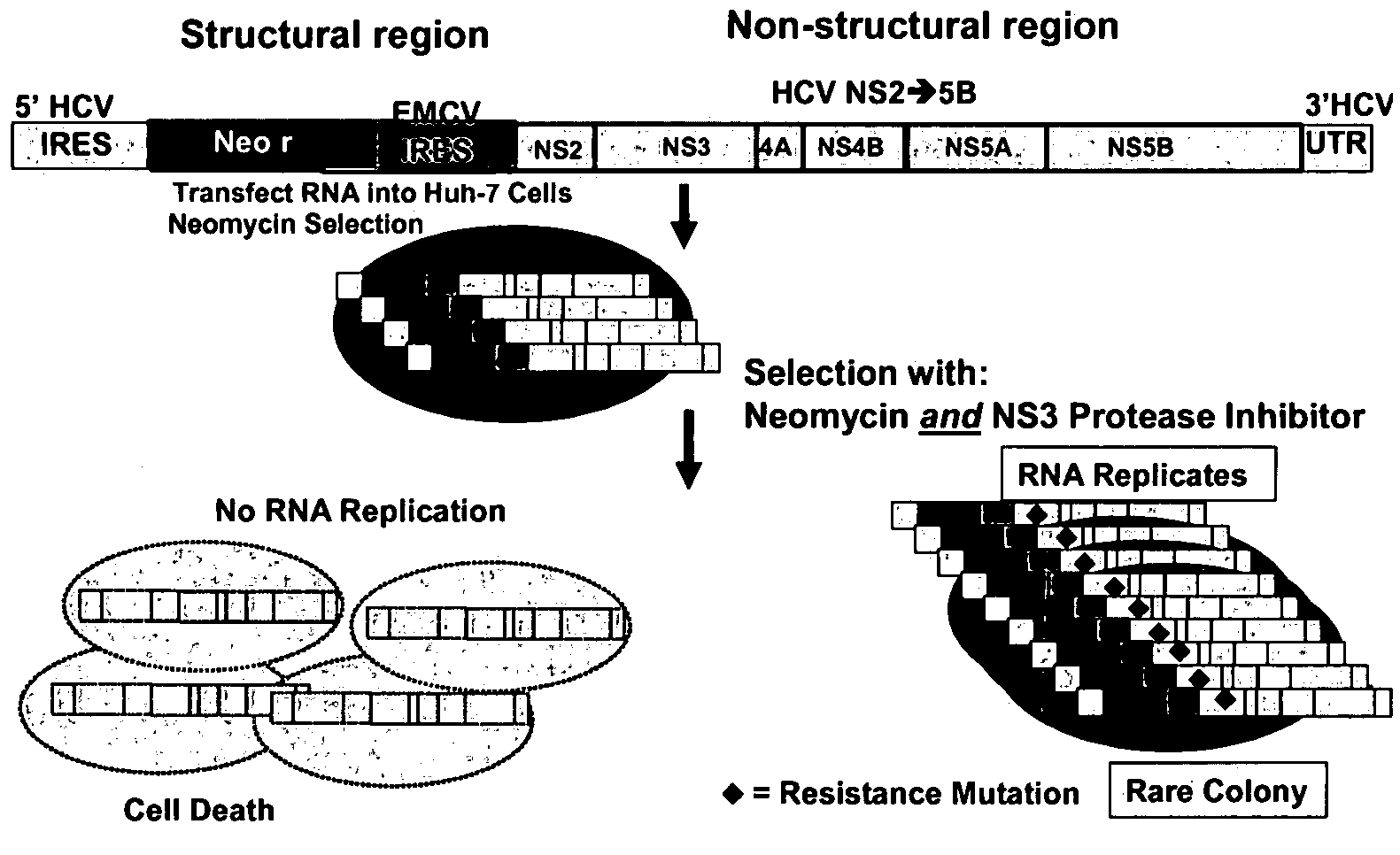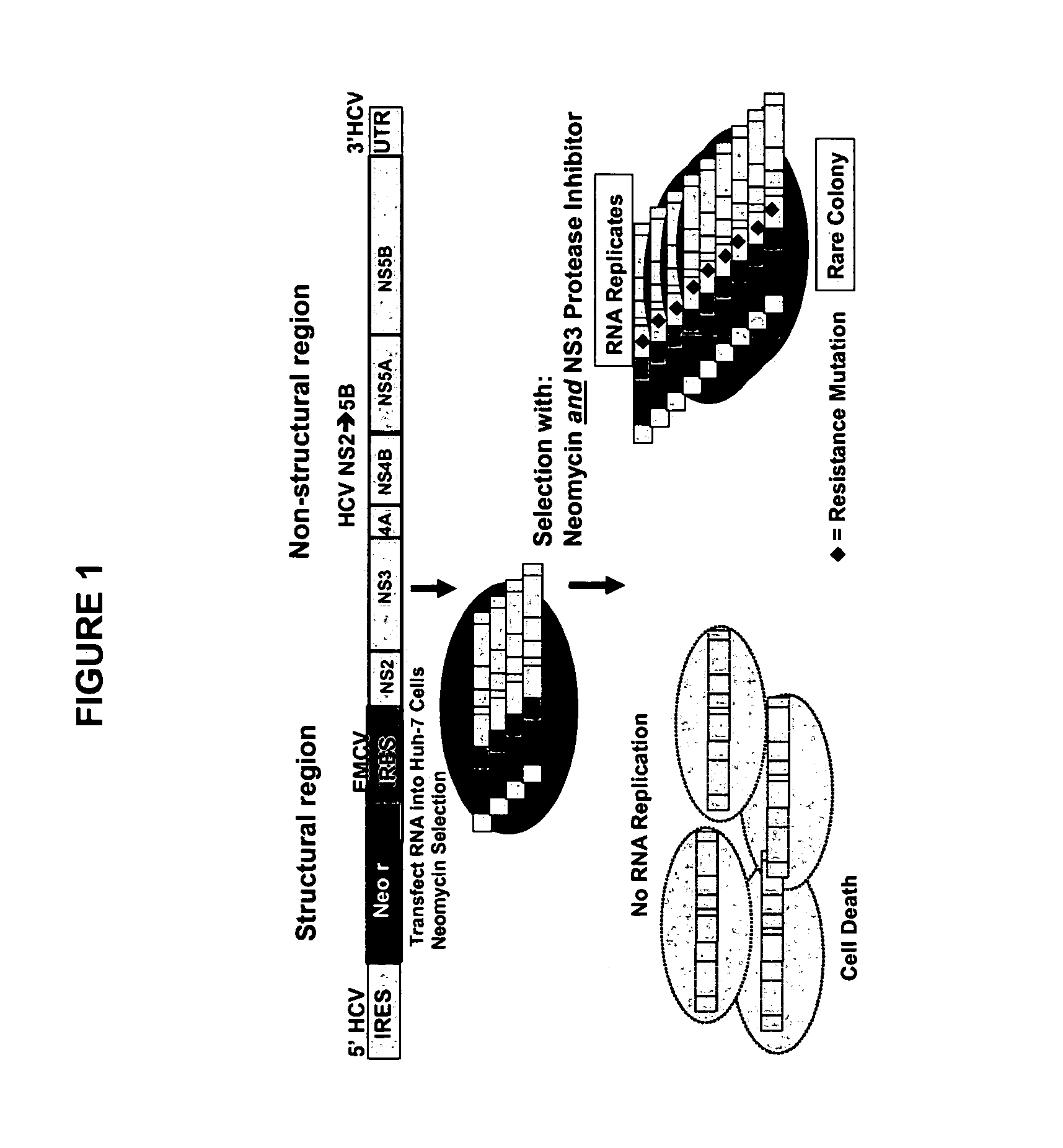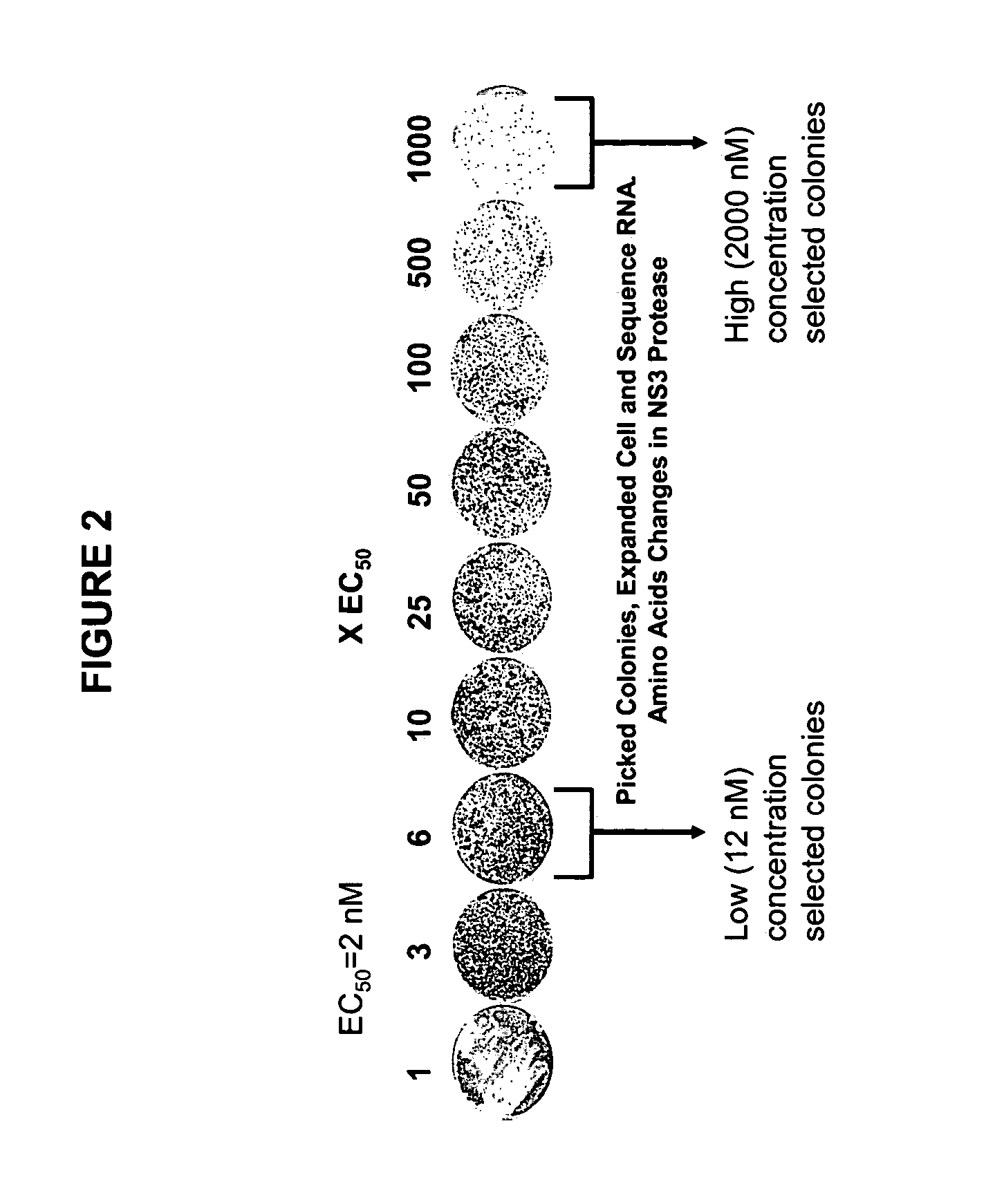Inhibitor-resistant HCV NS3 protease
a protease and inhibitor technology, applied in the field of new drugs, can solve the problems of not eliciting sustained antiviral responses in the majority of patients, and the role of cellular and humoral immune responses to protect against hcv infection and disease has not yet been established, and achieves the effect of reducing the activity of the proteas
- Summary
- Abstract
- Description
- Claims
- Application Information
AI Technical Summary
Benefits of technology
Problems solved by technology
Method used
Image
Examples
example 1
Identification of HCV NS3 Mutants Resistant to a Macrocyclic Peptide HCV Inhibitor
[0101]The method described by Lohmann et al. (1999, Science 285:110) was used to mimic the replication of subgenomic HCV RNA in a system that is dependent on the function of HCV non-structural proteins and enzymes. This HCV RNA replicon system incorporates two cistrons: one encoding the HCV non-structural region and the second encoding a selectable neomycin resistant marker (i.e. gene encoding neomycin phosphotransferase). As one of skill in the art will appreciate, the second cistron may encode any marker suitable for selection purposes. Cell lines harboring such bicistronic, subgenomic HCV RNA, such as the S22.3 cell line, are described by Kukolj and Pause (see WO 02 / 052015, the contents of which are hereby incorporated by reference). These cell lines are useful in evaluating the efficacy and potency of potential anti-HCV therapeutics that inhibit one or more of the HCV non-structural proteins.
[0102]...
example 2
Identification of HCV NS3 Mutants Resistant to NS3 Inhibitor B
[0110]The method described above in Example 1 was used to identify NS3 protease mutants that occurred by growth in the presence of NS3 protease inhibitor:
inhibitor B=cyclopropane carboxylic acid, N-[(cyclopentyloxy)carbonyl]-3-methyl-L-valyl-(4R)-4-[[2-[2-(acetylamino)-4-thiazolyl]-7-methoxy-4-quinolinyl]oxy]-L-prolyl-1-amino-2-ethenyl-, (1R,2S)-, which has an EC50 of 40 nM.
[0111]Colonies emerging in the presence of low (3×EC50 or 120 nM) and high (50×EC50 or 2000 nM) concentrations of inhibitor were expanded and the replicon RNA was sequenced over the NS3 / 4A region using standard sequencing techniques. Mutations detected in the NS3 protease domain at both high and low inhibitor concentrations are summarized below in Table 2.
[0112]
TABLE 2HighLow Inhibitor [ ] (120 nM)Inhibitor [ ] (2000 nM)nucl changeAA changenucl changeAA changeC467GA156GC467TA156VG115A–C430T–A39T L144FC467TA156VA503TD168VA503GD168GC467TA156VC266T–G464AP...
example 3
Identification of HCV NS3 Mutants Resistant to Another NS3 Inhibitor
[0113]The method described above in Example 1 was used in conjunction with NS3 protease inhibitor:
[0114]inhibitor C=Cyclopropa[e]pyrrolo[1,2-a][1,4]-diazacyclopentadecine-14a(5H)-carboxylic acid, 2-[[2-[2-(acetylamino)-4-thiazolyl]-7-methoxy-4-quinolinyl]oxy]-6-[[(1,1-dimethylethoxy)carbonyl]amino]-1,2,3,6,7,8,9,10,11,13a,14,15,16,16a-tetradecahydro-5,16-dioxo-, (2R,6S, 12Z, 13aS, 14aR, 16aS)-,
which is also described as compound #702 in WO 00 / 59929 (incorporated herein by reference) which has an EC50 of 5 nM.
[0115]Colonies emerging in the presence of low (6×EC50 or 30 nM), intermediate (20×EC50, 100 nM) and high (100×EC50, 500 nM and 200×EC50, 1000 nM) concentrations of inhibitor were expanded and the replicon RNA was sequenced over the NS3 / 4A region using standard sequencing techniques. Mutations detected in the NS3 protease domain at different concentrations are summarized below in Table 3.
[0116]
TABLE 3Low Inhibit...
PUM
| Property | Measurement | Unit |
|---|---|---|
| concentration | aaaaa | aaaaa |
| concentration | aaaaa | aaaaa |
| pH | aaaaa | aaaaa |
Abstract
Description
Claims
Application Information
 Login to View More
Login to View More - R&D
- Intellectual Property
- Life Sciences
- Materials
- Tech Scout
- Unparalleled Data Quality
- Higher Quality Content
- 60% Fewer Hallucinations
Browse by: Latest US Patents, China's latest patents, Technical Efficacy Thesaurus, Application Domain, Technology Topic, Popular Technical Reports.
© 2025 PatSnap. All rights reserved.Legal|Privacy policy|Modern Slavery Act Transparency Statement|Sitemap|About US| Contact US: help@patsnap.com



